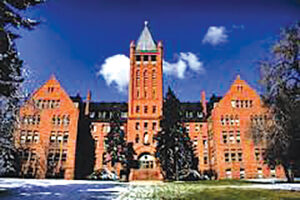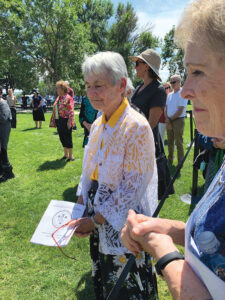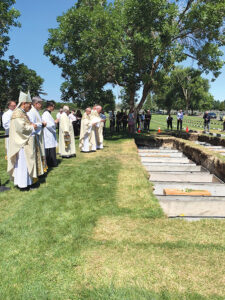 Compiled By Peggy DeStefano
Compiled By Peggy DeStefano In 1886, determined Sisters of Loretto arrived in Denver where they proceeded to found a Catholic girls’ high school. They made their way here in covered wagons following the Santa Fe Trail as they travelled West. No cowards these!
Prior to coming to Colorado, the Sisters of Loretto began because a small band of women left their Maryland settlement for Kentucky (where they still have their mother house) to escape the discrimination against church members in the east. Three young women established the Loretto order on April 25, 1812.
The group was criticized by the Pope (Pope Pius VII) for their “radical feminism.” Yes, the Sisters of Loretto believed girls and women should have an education. They maneuvered themselves so none of the Bishops or even the Pope could deter them from their goals.
On their journey West, they first had to overcome cholera which affected them as they were ascending the Missouri River by steamboat. Then the Sisters rode in their buggies through a mighty storm on the open plains. They narrowly escaped from 400 Indians which surrounded their caravan.
Their first landing place was Santa Fe, New Mexico. On their arrival to New Mexico they passed under triumphal arches, heard church bells clanging and struggled with their buggies to get through adoring crowds. It was 1852.
 As New Mexico became less wild, additional ranks of teachers were summoned from Kentucky to staff new Loretto schools in such places as Taos, Mora, Las Vegas, Albuquerque, Bernalillo, Socorro and Las Cruces. Their contribution to education in the territory was enormous.
As New Mexico became less wild, additional ranks of teachers were summoned from Kentucky to staff new Loretto schools in such places as Taos, Mora, Las Vegas, Albuquerque, Bernalillo, Socorro and Las Cruces. Their contribution to education in the territory was enormous. Three Sisters came to Colorado from Santa Fe in June of 1864 under the escort of Bishop Joseph Machebeuf, who recruited them as educators. Loretto sisters handed out the state’s first high school diplomas at St. Mary’s Academy in what was then Colorado territory.
They then founded Loretto Heights Academy as a Catholic girls’ high school in 1886 in Denver, Colorado.
The Sisters were enterprising. They purchased the 76 acres of land that sat atop the hill at 3001 South Federal Boulevard. They had one of Denver’s premier architects, Frank E. Edbrooke design their landmark administration building.
Over the years, the school became a college that included teacher-education programs, nursing programs, and classes in business and dance for both men and women. They even had a stable for horses through the mid-sixties. Students could bring their horses to school with them.
The nuns also provided a ministry which spanned education, health care, hospice and even lobbying. The sisters are teachers, nurses, lawyers and administrators. They serve the elderly, youth, poor, homeless, imprisoned and immigrants.
 The Sisters of Loretto even made sure they had a final resting place for the sisters of their order. The cemetery on campus was the burial ground for dozens of nuns who provided instruction at the Loretto Heights College. Sixty-two nuns were buried there— some more than a century ago.
The Sisters of Loretto even made sure they had a final resting place for the sisters of their order. The cemetery on campus was the burial ground for dozens of nuns who provided instruction at the Loretto Heights College. Sixty-two nuns were buried there— some more than a century ago. But this unusual situation is finally changing. The nuns’ remains have now been relocated to Mount Olivet Catholic Cemetery, 12801 West 44th Avenue in Wheat Ridge, after more than a half-decade of discussion and debate. Meanwhile, the campus was put on the block, and it had plenty of attributes: fourteen buildings spread out over 76 acres, including a 1,000-seat theater (a theater that hosted the Russian ballet, a Japanese tea ceremony, the joint choirs of Loretto Heights and the Air Force Academy, several writers and poets like Black Like Me author John Howard Griffin and British poet Paul Roche) , an interfaith chapel, a swimming pool, a cafeteria, residence halls and recreational amenities. The focal point of the campus was the landmark administration building designed by one of Denver’s premier architects, Frank E. Edbrooke, that was added to the National Register of Historic Places in 1975. (Thank God the nuns did this because now they can’t tear down these buildings.)
Westside Investment Partners, which bought the campus in 2018, was reportedly open to building around the cemetery. But in the end, the decision was made to move the graves to Mount Olivet and construct what’s characterized as a “memorial garden” in their honor where the nuns had previously been buried.
Over 120-plus years, the hilltop campus on south Federal Boulevard has been an academy for girls, a World War I military training ground, Teikyo Loretto Heights University, and perhaps most famously, Loretto Heights College. To Martha Kirkpatrick, who graduated in 1982, Loretto Heights College was “a magical place” — a tight-knit community of dedicated students and talented teachers and professors.
The Sisters of Loretto were truly pioneers in education. Much of their curriculum was similar to many Ivy-league universities including Harvard. They also developed programs like “University Without Walls” which made it possible for students to take courses at other institutions and apply them to their degree program.
The college became part of Regis University in 1988, and the campus was sold. Regis continues several of Loretto Heights’ programs, most well-known is their nursing program.
Now, it is on the brink of yet another incarnation: a mixed-use residential and commercial development. On a late-May afternoon, dozens of Loretto Heights alumni got a last look at the college and its buildings. Kirkpatrick, who led some of the tours of tiny dorm rooms and even a climb up the bell tower, said she is grateful the developers are honoring the campus’ history, and that the iconic administration building, the chapel and perhaps other buildings will be preserved. “I’m very hopeful for what the future holds.”
In 1989, the campus was transformed into Teikyo Loretto Heights University, which focused on attracting international students. Two decades later, in 2009, Teikyo University Group, a multi-national education foundation based in Japan, opened Colorado Heights University, a nonprofit private institution, on the grounds, and Denver Public Schools also operated several programs there.
Denver City Council approved rezoning for the area in May 2021, formally sanctioning a plan approved two years earlier that pledged “preservation and maintenance of the historic buildings on campus; a better pedestrian experience and improved mobility through street improvements and new bike lanes; development that matches the patterns of surrounding neighborhoods; for-sale and for-rent affordable housing, including units for families (two bedrooms or more) for a wide range of incomes; and climate friendly construction that will be the first major residential development in Denver to test the Denver Green Code.” Among the centerpieces of these efforts was the transformation of the school’s Pancratia Hall (my dorm) into 72 affordable apartments; the renamed Pancratia Hall Lofts opened in May.
Other buildings that will be preserved include: The main administration building, opened in 1891, which was designed by Frank Edbrooke, who also designed Denver’s Brown Palace Hotel. The 121-year-old administration building, listed on the National Register of Historic Places, will remain on the Loretto Heights campus as will the chapel. (The college’s historic bell will also remain on campus.)
During the Loretto Heights College era, the cafeteria in Machebeuf Hall, which was built in 1960, doubled as a gathering spot and student union. It was, in fact, where I met my future husband Jon at a college mixer. Loretto Heights was still an all-girl college and Jon went to Regis which was an all-boy college. That was in 1963. Now in 2022 we have just celebrated our 55th wedding anniversary. Loretto Heights will live forever in our memories.
The Sisters of Loretto, because of financial pressures, had to relinquish their historic and beloved Loretto Heights campus in Denver in 1988.
Sisters of Loretto Recommittal Held at Mount Olivet Catholic Cemetery at the Gallagher Chapel August 22, 2022.
History of Mt. Olivet
The site of Mt. Olivet Catholic Cemetery is a 440-acre farm located in rural Jefferson County between Denver and Golden which was purchased in 1860s by Bishop Joseph Projectus Machebeuf, Denver’s first resident bishop. Bishop Machebeuf later donated the land to the Catholic Diocese of Denver.
Mount Olivet Cemetery is a Roman Catholic cemetery operated by the Archdiocese of Denver. The cemetery is located at 12801 W. 44th Avenue in Wheat Ridge, Colorado. It is the first cemetery owned and operated by the Archdiocese of Denver, the second being Saint Simeon Catholic Cemetery in Aurora, Colorado.
Mt. Olivet Cemetery was consecrated on September 25, 1892 by Bishop Nicholas Chrysostom Matz. On that day, a special Union Pacific train left Denver Union Station carrying 1,500 people to Mt. Olivet for the cemetery consecration. Bishop Matz officiated at the dedication and described Mt. Olivet as the “new City of the Dead.”
The primary Denver cemetery until that time had been Prospect Hill Cemetery, southeast of the city. In 1890 the city designated those grounds to be turned into a park. The Catholic section of Prospect Hill Cemetery was then renamed Mount Calvary Cemetery. The first burial at Mt. Olivet Cemetery was Elizabeth Kelley of Annunciation Parish on July 5, 1892. An examination of the record book of Mt. Olivet tells a graphic history of the times. Causes of death entered in the late 1800s include “died of softening of the brain,” and “died of acute insanity,” and “died of cramps.” Other poignant entries include a mother and child “killed by Indians” August 26, 1868. Six members of another family were killed in a snow slide on March 10, 1884; 12 members of the family now lie together, side by side, at Mt. Olivet.
Relatively isolated, visitors often came to Mt. Olivet by horse and buggy. Union Pacific funeral trains made almost daily trips from Denver to Mt. Olivet. The trains were met by teams of ponies or horses, hitched to funeral biers, to travel up the long drive into the cemetery proper. It took almost an entire day for a funeral cortege to travel by train to Mt. Olivet and back to Denver. Later, interurban street cars served as funeral cars.
In 1871, the first tram service from Denver was by horse-drawn trams. In 1886, they were replaced by electric trams. The route from Denver to Golden was known as the “Wishbone” Route and was luxury, comfort, and speed. In 1891, Bishop Matz announced that Old Calvary Cemetery had been condemned by the city of Denver and proclaimed that Catholics should use Mount Olivet Cemetery for burials. The Union Pacific Railroad agreed to build a funeral car, special funeral train, and a depot near the cemetery. The charge for roundtrip was fifty cents.
Colorado’s largest and most deadly influenza outbreak arrived on or about September 20, 1918. It did not take long for it to spread throughout the state. On October 7, a statewide advisory was posted to close public places and gatherings. By October 16, people were prohibited from entering Colorado by rail or horseback. People coming from other states were quarantined at least two days at all of the borders. All schools and government offices were closed for weeks and weeks. This pandemic was the largest outbreak in recorded history, spanned from 1918 to 1925. Victims of the outbreak are buried in many locations at Mt. Olivet cemetery including Sections 12, 14, 22, and 26.
Gallagher Memorial Chapel
Gallagher Memorial Chapel, dedicated in 1939, “stands guard” over the entire Mt. Olivet Cemetery. Mary J. Gallagher donated the chapel as a mausoleum for the Bishops and Archbishops of Denver, in memory of her husband “Reddy” Gallagher. Reddy was a red-headed, colorful boxer and wrestler who was a major proponent of the sport of boxing in Denver and had a long career as a sports columnist for The Denver Post.
Mt. Olivet succeeded Mt. Calvary, the first Catholic cemetery in Denver, located at 900 York Street, which is now part of Cheesman Park and the Denver Botanic Gardens. After Mt. Olivet became the principal Catholic cemetery, Mt. Calvary was closed.
In 1950, the land of Mt. Calvary Cemetery was sold by the Archdiocese of Denver to the City of Denver with the provision that it would not be used for commercial purposes, and that the city would pay the expenses of reinterring the bodies from Mt. Calvary to Mt. Olivet. In 1950, from June to September, the remains of more than 7,000 persons were moved from Mt. Calvary to Mt. Olivet. Most of the bodies were reinterred in Section 24 while about 1,000 where buried elsewhere at Mt. Olivet, in family plots. Extraordinary care was taken to ensure that the remains of each person were carefully identified and transferred and the new burial spot was painstakingly marked. Of the total buried at Mt. Calvary, approximately 50% were infants and children. Amazing mementos were found when graves were opened. Several disinterred bodies were of men in full military uniform, including spurs and swords. One grave contained several newspapers dating back to April 22, 1905; a copy of The Boston Post headlined the opening game of the American League between Philadelphia and Boston, in which Rub Waddell saved the day for Philadelphia.
Another astonishing tale from men who worked on the project relates that when the grave of an Irish woman from Leadville was uncovered, the scent of rose petals filled the air. There was great consternation that the body of a saint might have been disinterred. Her sanctity terrified all. This created great problems for Church officials who had to verify or deny the saintliness. Despite intensive research by The Denver Catholic Register, the Irish woman remains a mystery.
Some of the greatest orators of Denver preached at the Memorial Day Masses. Orators like Msgr. William O’Ryan, Msgr. Hugh L. McMenamin, Msgr. Francis Walsh, and Fr. E. J. Mannix delivered stirring sermons on patriotism and the virtue of praying for souls of the dead. In one of his sermons at a Memorial Day Mass, Bishop Tihen reportedly urged those at Mass to visit the cemetery often, to bring their picnic lunches and enjoy the beauty as a park of inspiration.
Notable burials – Mount Olivet Cemetery
• Bishop Joseph Projectus Machebeuf, 1st Bishop of Denver (1887-1889)
• Bishop Nicholas Chrysostom Matz, 2nd Bishop of Denver (1889-1917)
• Bishop John Henry Tihen, 3rd Bishop of Denver (1917-1931)
• Archbishop Urban John Vehr, 4th Bishop (1931-1941) and 1st Archbishop of Denver (1941-1967)
• Archbishop James Vincent Casey, 2nd Archbishop of Denver (1967-1986)
• Julia Greeley (“Denver’s Angel of Charity”), buried at Mt. Olivet Cemetery in 1918. As part of the Cause for Canonization, her remains were transferred to the Cathedral Basilica of the Immaculate Conception on June 7, 2017.
• William Gilpin (governor), 1st Governor of the Territory of Colorado 1861-1862
• John “Jack” Swigert, Command Module Pilot aboard Apollo 13 and Colorado Congressman
• Jacques Benedict, one of the most prominent architects in Colorado history
• May Bonfils Stanton, Colorado heiress and philanthropist • Michael James Dempsey, American-born Catholic bishop in Nigeria
• Jerry McMorris, former principal owner of the Colorado Rockies
• William H. McNichols, Jr., Denver Mayor 1968
• Verner Zevola Reed, Colorado pioneer and businessman
• Mary Johnson Reed, wife of Verner Reed and philanthropist
• Baby Doe Tabor, flamboyant wife of Horace Tabor, and inspiration for the opera The Ballad of Baby Doe
• Horace Tabor, Colorado pioneer and businessman
• Martin D. Currigan, building contractor and city councilman in Denver, Colorado
• John Kernan Mullen, an Irish-American businessman and philanthropist
• John Francis Campion, businessman and philanthropist
• Sister Mary Lucy Downey (Sisters of Charity of Leavenworth), founder of Archdiocesan Housing
• William and Dorothy Harmsen, Founders of Jolly Rancher Candy Company
• Daniel Mauser, Matthew Kechter, Kelly Fleming, victims of the Columbine High School massacre
• Sisters of Loretto, reinterred from Loretto Heights College campus (2022)















Follow Us